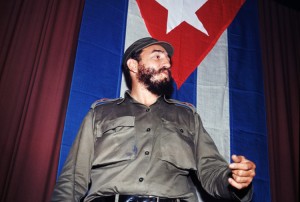Fidel Castro (1926-2016)
November 28, 2016
Early this morning, November 28, tens of thousands of Cubans began lining up ahead of a mass gathering in Havana’s Revolution Square to honor the life of former dictator and president, Fidel Castro. Castro, a guerrilla leader who led a Communist revolution in Cuba and ruled the island from 1959 to 2008, died on Friday, November 25, at the age of 90. Castro’s younger brother, Raúl, has ruled Cuba since 2008.
Castro was cremated on Saturday, November 26. An urn containing his ashes is on display in Havana, the capital, until late tomorrow night. From there, a cortege will carry Castro’s remains 750 miles (1,200 kilometers) to a final resting place in Santiago de Cuba, the city in eastern Cuba where Castro launched the revolution. Castro will be buried on Sunday, December 4, ending the government’s nine-day period of mourning.
After word of Castro’s death spread on Friday, music was quieted in the capital, and flags were lowered to half-staff. The government temporarily banned alcohol sales and suspended the professional baseball season. Commenting carefully on the controversial Castro, U.S. President Barack Obama said it was up to history to “record and judge the enormous impact of this singular figure on the people and world around him.” Obama also reassured Cubans that they would always “have a friend and partner in the United States of America.” Conversely, U.S. President-elect Donald Trump called Castro “a brutal dictator who oppressed his own people for nearly six decades.” Trump has pledged to “reverse” the efforts of the Obama administration to normalize relations between Cuba and the United States.
Fidel Castro was born on Aug. 13, 1926, in Biran, near Mayari, Cuba. He graduated with a law degree from the University of Havana in 1950 and briefly practiced law in the capital. In 1952, he ran for election to the Cuban House of Representatives. But troops led by former president Fulgencio Batista halted the election and ended democracy in Cuba.
As a result of Batista’s actions, Castro tried to start a revolution against the Batista dictatorship. On July 26, 1953, Castro’s forces attacked the Moncada army barracks in Santiago de Cuba. Castro was captured and sentenced to 15 years in prison. Batista released him in 1955, however. Castro then formed the 26th of July Movement, a group of revolutionaries named after the date of his first revolt. He then went into exile in Mexico. Castro’s forces landed in Cuba in December 1956. Many rebels were killed, and Castro and other survivors fled to the Sierra Maestra, a mountain range in southeast Cuba. People from the surrounding countryside joined the rebellion. Batista fled from Cuba on Jan. 1, 1959, and Castro took control of the government.
Castro seized property owned by Americans and other foreigners as well as Cubans. In 1960, the Castro government took over United States oil refineries in Cuba. The United States then stopped buying Cuban sugar. Castro responded by taking over all United States businesses in Cuba.
Castro supported a number of revolutionary movements in South America, Central America, and Africa. The Castro government provided improved education and health facilities for many Cubans. But the economy often was troubled. In the early 1960′s, Cuba began depending heavily on the Soviet Union for economic support. This support ended in 1991, when the Soviet Union was dissolved. Castro vowed that Cuba would remain a Communist country. However, in the early 1990′s, Cuba undertook limited reforms that loosened state control over parts of the country’s economy.
In the 2010′s, relations improved significantly between Cuba and the United States. The U.S. government under President Obama eased some economic and travel restrictions regarding Cuba. The Cuban government made it easier for Cubans to leave the country. It also released some prisoners considered political dissidents (people who disagree with the government). In 2015, Cuba and the United States reopened their foreign embassies in each other’s capitals, officially restoring diplomatic relations after more than 50 years. In 2016, Obama visited Cuba and met with President Raúl Castro. It was the first visit by a sitting U.S. president in almost 90 years.



